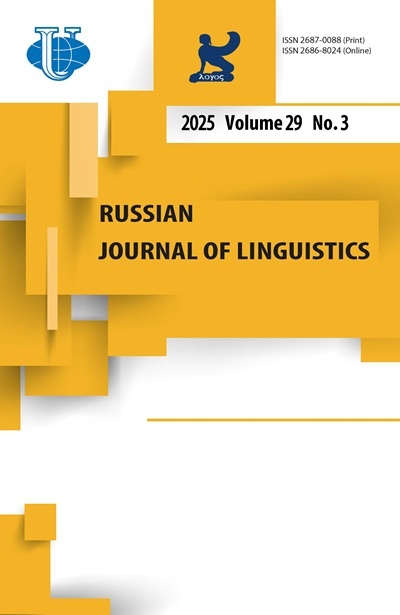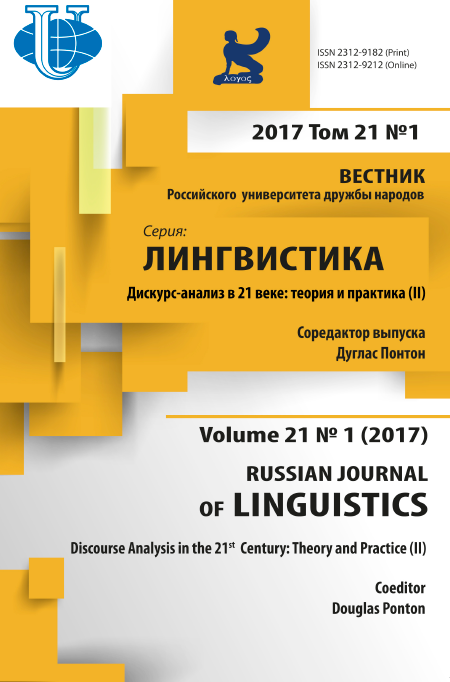«Передовой опыт» Уолмарта: анализ неоднозначной экополитики)
- Авторы: Аббамонте Л.1, Кавальери Ф.2
-
Учреждения:
- Второй Университет Неаполя
- Неаполитанский университет имени Фридриха II
- Выпуск: Том 21, № 1 (2017): Дискурс-анализ в 21 веке: теория и практика (II)
- Страницы: 105-125
- Раздел: Статьи
- URL: https://journals.rudn.ru/linguistics/article/view/15407
- DOI: https://doi.org/10.22363/2312-9182-2017-21-1-105-125
- ID: 15407
Цитировать
Полный текст
Аннотация
В настоящее время компании, желая привлечь внимание покупателей, заботящихся об окружающей среде, все чаще апеллируют к идеям экологичной экономики. Это обусловлено увеличением категории потребителей экопродукции и массовой популяризацией концепции «экологической безопасности». Термин «экологичность» постепенно становится основной смысловой единицей рекламных и медийных проектов всех перспективных компаний, так как способствует формированию позитивной корпоративной репутации. Международная американская сеть розничной торговли Уолмарт (Walmart) позиционирует себя как «зеленая компания» и активно использует методы экологичного маркетинга. Например, на первой странице поисковой системы Google по запросу «экологичность» выдается веб-адрес корпорации: http://corporate.walmart.com/global-responsibility/sustainability. На официальном сайте «Уолмарт» сообщается, что компания стремится не только к расширению бизнеса, но также озабочена состоянием окружающей среды и фундаментальными социальными проблемами. Тем не менее, в последнее время Уолмарт часто обвиняют в серьезных нарушениях экологических норм, в частности в сокрытии реального объема вредных выбросов в процессе использования возобновляемых источников энергии. Основной причиной столь острой критики является неспособность компании предложить адекватное решение существующих проблем (Laclau and Mouffe 1985). Все это вызывает большой резонанс среди общественности и СМИ. Несмотря на двойственный, противоречивый характер деятельности корпорации Уолмарт (Macgilchrist 2007), в данной статье подчеркиваются ее положительные аспекты, в частности позитивное отношение компании к таким значимым проблемам, как энергетика, отходы и др. В статье используется комплексный критический дискурс-анализ, с помощью которого изучаются нюансы стратегий маркетинга и брендинга. Исследование направлено на изучение различных коммуникативных стратегий, мультимодальных средств, которые используются для создания привлекательных рекламных образов, способствующих формированию у реципиента чувства экологической и социальной ответственности.
Об авторах
Лючия Аббамонте
Второй Университет Неаполя
Email: lucia.abbamonte@unina2.it
81100, Казерта, Италия, Viale Beneduce 10
Флавия Кавальери
Неаполитанский университет имени Фридриха II
Email: fcavalie@unina.it
1 80133 Неаполь, Италия, Via Porta di Massa
Список литературы
- Abbamonte, L. (2014). Restorative Justice. L’importanza della diffusione e della condivisione. In Marco A. Quiroz Vitale (ed.). Diritto, il dono di Epimeteo. Dialoghi tra Diritto, Teoria e Sociologia del diritto. Milano: Mimesis
- Abbamonte, L., & Cavaliere, F. (2012). Restorative Justice and Mediation - The Healing Power of Language. In AAVV. Explorations in Language and Law. Approaches and Perspective. Aprilia (Lt): Novalogos vol. 1
- Abbamonte, L., & Cavaliere, F. (2013). Restorative Justice, a comparative analysis of discursive practices: dialogistic exchanges in the USA and Italy. In C. Williams & G. Tessuto (Eds), Language in the Negotiation of Justice: Contexts, Issues and Applications. Farnham, Surrey: Ashgate Publishing
- Abbamonte, L. (2012). Integrated Methodology for Emotion Talk in Socio-legal Exchanges. Politeness, Accommodation and Appraisal Insights. Napoli: Edizioni Scientifiche Italiane
- Adams, C.J. & Gruen, L. (Eds.) (2014). Ecofeminism: Feminist Intersections with Other Animals and the Earth. New York: Bloomsbury Academic
- Ascher, S., & Pincus, E. (2013). The Filmmaker’s Handbook: A Comprehensive Guide for the Digital Age. New York: Plume
- Bateman, J. (2014). Text and Image: A Critical Introduction to the Visual/Verbal Divide. London and New York: Routledge
- Bourdieu, P. (1980). Structure, habitus, practices. In P. Bourdieu. The logic of practice. Cambridge: Polity Press in association with Blackwell Publishers
- Caldas-Coulthard, C. & Coulthard, M. (Eds.) (1996). Text and Practices: Readings in Critical Discourse Analysis xi-xii. London: Routledge
- Chandler, D. (2016). Camera Techniques: Distance and Angle. The ‘Grammar’ of Television and Film. http://visual-memory.co.uk/daniel/Documents/short/gramtv.html
- Christie, F. &. Martin, J.R. (Eds.) (2000). Genres and Institutions: Social Processes in the Workplace and School (3rd ed.). London, Cassell
- Cox, R. (2012). Environmental Communication and the Public Sphere. London: Sage
- Dyer, G. (1988). Advertising as Communication. London and New York: Routledge
- Fairclough, N. & Wodak, R. (1997).Critical Discourse Analysis. In T.A. van Dijk (Ed.). Discourse Studies: A Multidisciplinary Introduction. Vol. II. London: Sage
- Falco S.N. (2015). Nasce il Marketing Transpersonale, il nuovo paradigma che cambia l’approccio alla disciplina. Retrieved from http://www.ninjamarketing.it/2015/05/20/marketing-transpersonale-nuovo-paradigma
- Fecteau, J. & Munoz, D.P. (2006). ‘Salience, relevance, and firing: a priority map for target selection’. Trends Cogn Sci. 382-90
- Fisher, A. (2013). Radical Ecopsychology: Psychology in the Service of Life (2nd ed). New York: State University of New York Press
- Fowler, J. (1976). Mass Advertising as Social Forecast: A Method for Future Research. New York: Praeger Publishers
- Fowler, J. (1996). Advertising and Popular Culture (Feminist Perspective on Communication). Thousand Oaks: Sage Publications
- Garrard, G. (Ed). (2014). The Oxford Handbook of Ecocriticism. Oxford: Oxford University Press
- Harré, R., Brockmeier, J., & Mühlhäuser, P.(1999). Greenspeak: A Study of Environmental Discourse. London: Sage
- Han, S., Lerner, J. & Keltner, D. (2007). Feelings and Consumer Decision Making: The Appraisal-Tendency Framework. Journal of Consumer Psychology, 17(3), 158-168
- Humphreys, M., & Garry, J. (2000). ‘Thinking about salience’. Early drafts from Columbia: 1-55
- Jaworski, A. and Coupland, N. (2006). The Discourse Reader. London, New York: Palgrave Macmillan
- Knickerbocker, S. (2012). Ecopoetics: The Language of Nature, the Nature of Language. Boston: University of Massachusetts Press
- Kress, G. (1996). Representational Resources and the Production of Subjectivity: Questions for the Theoretical Development of Critical Discourse Analysis in a Multicultural Society. In C. Caldas-Coulthard & M. Coulthard (Eds.). Text and Practices: Readings in Critical Discourse Analysis. London: Routledge
- Kress, G. (2000). Design and Transformation: New Theories of Meaning. In W. Cope & M. Kalantzis (Eds.). Multiliteracies: Literacy Learning and the Design of Social Futures. London: Routledge
- Kress, G. (2003). Literacy in the New Media Age. London: Routledge
- Kress, G. (2010). Multimodality. London and New York: Routledge
- Kress, G., & van Leeuwen, T. (1990). Reading Images. The grammar of visual design. Geelong: Deakin University Press
- Kress, G., & van Leeuwen, T. (2001). Multimodal Discourse: The Modes and Media of Contemporary Communication. Oxford, UK: Oxford University Press
- Laclau E. and Mouffe, C. (1985). Hegemony and Socialist Strategy: Towards a Radical Democratic Politics. London and New York Verso, (2nd Edition, 2001)
- Lagerwerf, L., van Hooijdonk, C.M.J., & Korenberg, A. (2012). Processing visual rhetoric in advertisements: Interpretations determined by verbal anchoring and visual structure. Journal of Pragmatics. 1836-1852
- Lakoff, G. and Johnson, M. (1980). Metaphors We Live By. Chicago: University of Chicago Press
- Lieberman, D. (2015). ‘YouTube Pitches Itself to Advertisers as the Medium of the Future’. Deadline. 29 April 2015. Retrieved from http://deadline.com/2015/04/youtube-advertising-newfront-future-video-1201418305
- Martin, J.R. (1992). English text. System and structure Philadelphia: John Benjamins Publishing Company
- Martin, J.R. (2000). Beyond Exchange: Appraisal Systems in English. In S. Hunston & G. Thompson (eds.). Evaluation in Text: Authorial Stance and the Construction of Discourse. Oxford: Oxford UP
- Martin, J.R. (2001). Fair Trade: Negotiating Meaning in Multimodal Texts. In P. Coppock (Ed.). The Semiotics of Writing: Transdisciplinary Perspectives on the Technology of Writing. Turnhout (Belgium): Brepols Publishing
- Martin, J.R. (2004). Positive discourse analysis: Solidarity and change. Revista Canaria de Estudios Ingleses, 49, 179-200
- Macgilchrist, F. (2007). Positive Discourse Analysis: Contesting Dominant Discourses by Reframing the Issues. Critical Approaches to Discourse Analysis Across Disciplines. 1 (1): 74-94
- Pallera, M. (2014). Un e-commerce ha quadruplicato il valore grazie all’amore. C’è un marketing che vende e migliora il mondo. Centodieci. Retrieved from http://www.centodieci.it/2014/12/dal-marketing-3-0-spiritualita-quando-lazienda-risuona-lanima
- Robbins, P. (2012). Political Ecology: A Critical Introduction. (2nd ed.). MA: Blackwell
- Saward, N. (2012). Lines of appeal. SSC Media Studies... Retrieved from http://sssfcmediastudies. blogspot.it/2012/10/lines-of-appeal-advertisements-homework.html
- Soojung, K. and Oh, J. S. (2009). Best-answer selection criteria in a social Q&A site from the user-oriented relevance perspective. Proceedings of the Association for Information Science and Technology, 44(1), 1-15
- Sperber, D. and Dan, W. [1986] 1995. Relevance: Communication &Cognition. Oxford: Blackwell
- Stevens, P. (2012). Towards an ecosociology. Sociology, 46(4), 579-595
- Stibbe, A. (2016). Ecolinguistics: the search for new stories to live by. Seminar - Catania (It) 7 September
- Stinson, J. (2012). All About Camera Angles. The Videomaker. Retrieved from https://www.videomaker.com/article/f5/9128-all-about-camera-angles
- van Leeuwen, T. (2008). Introducing Social Semiotics. London and New York: Routledge
- van Leeuwen, T. (2013). Colour Schemes. In M. Boeck, & N. Pachler (Eds.). Multimodality and Social Semiosis: Communication, Meaning-Making, and Learning in the Work of Gunther Kress. London: Routledge
- White, P.R.R. (1998). Telling Media Tales: the News Story As Rhetoric. Unpublished PhD, University of Sydney, Sydney. Retrieved from http://www.grammatics.com/appraisal/Appraisal KeyReferences.html
Дополнительные файлы















